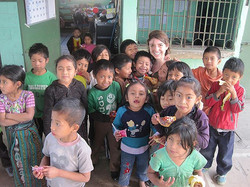 Rachel with students at the Panabaj Elementary School
Rachel with students at the Panabaj Elementary School For many years, I’ve helped non-profit organizations with fundraising by organizing promotional campaigns and planning events. My passion for volunteering was ignited by my Communications studies at the University of Massachusetts, where my professors taught me to look beyond advertisements to the origins of goods that are produced in developing countries. I learned that often the workers who produce these goods are employed under harsh conditions and barely paid enough to survive. This motivated me to volunteer for organizations that sought to address these inequalities.
I have a knack for marketing and outreach, so in my free time, I use my skills to support organizations that are working to better society. Despite my deep involvement in development and public relations with the non-profit sector, I had never ventured internationally to see the work that I was helping to fund. Traveling to Guatemala with Pueblo a Pueblo was my first opportunity to witness the kind of impact my time and donations are making in impoverished communities.
As I rode in the back of a beat-up van, I was unsure of what I would discover in Santiago. What would Pubelo a Pueblo’s office look like? What was the staff like? Where were the funded projects located in relation to the staff? Who monitored the projects? My mental list of questions grew. I’d read disturbing news articles about NGOs whose donor funds were largely funneled to American directors instead of the developing countries they were intended to help. But this was hardly the case with Pueblo a Pueblo. During my brief trip, I was able to see a number of successful projects that were making real differences in the lives of the desperately poor people of Guatemala.
My first site visit was to a community called Nueva Providencia. People here lived in structures that resembled the forts I built in my backyard when I was a toddler. The homes had dirt floors, no doors, and leaky roofs. The children were malnourished and unkempt. Pueblo a Pueblo supports this community through their WASH program, which fosters healthy school environments by improving sanitation facilities, hand washing stations, and by providing access to safe drinking water. In Nueva Providencia, Pueblo a Pueblo funded the construction of restrooms with flush toilets to replace the holes in the ground that previously served as people’s toilets. The community expressed their gratitude through an hour-long inauguration ceremony that featured a ribbon-cutting , followed by dances and speeches. I was moved by the community’s appreciation for something I take for granted every day.
While in Guatemala, I was also able to see the foundations of what will become abundant organic gardens in Nueva Providencia and Panabaj. And I saw children in school who are financially supported by Pueblo a Pueblo and encouraged by the staff to complete sixth grade. I saw firsthand that your dollars are making a difference.
I often question whose role it is to provide international aid, what the most effective mechanism is of providing aid, and how an organization like Pueblo a Pueblo avoids imposing Western ideals on the Mayan and Guatemalan culture. I do feel, however, that if we Americans have the knowledge and wealth to produce positive, sustainable change for indigenous peoples, then we are obligated to do so.
We should help improve those conditions associated with poverty by helping to improve nutrition, sanitary conditions, and access to education. By hiring locals and American staff well versed in Guatemalan history, Pueblo a Pueblo is striving to provide aid in a culturally appropriate manner. As a result of my trip, I can confidently advocate for Pueblo a Pueblo.
On that note, if you have time to escape the American rat race, I highly recommend traveling to Guatemala. The vibrant landscape and the richness of the Mayan culture are breathtaking and humbling. I was reminded that as an American, I was dealt a really nice hand of cards. This reality check is invaluable and I encourage all to experience it.

 RSS Feed
RSS Feed